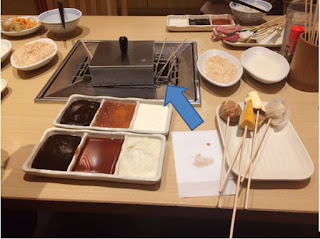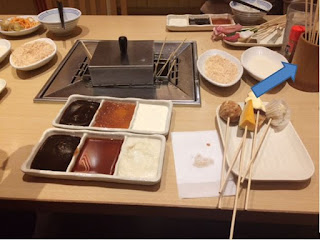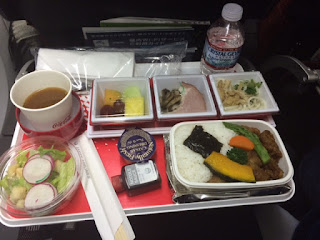So there was an earthquake this morning. That was wild. I may or not have bawled in fear even though it was very mild down where I was. Japan is used to it. My husband and sister-in-law almost literally rolled over and went back to sleep. Apparently there was another quake the day before yesterday and I never even knew it.
I went through the whole day and everything was 100% absolutely normal. People will be happy to hear that even the area hit hardest (Fukushima) suffered extremely little damage and only a few minor injuries from falling furniture and things. The tsunami warning in Fukushima has been lifted and it seems that damage has been minimal. But we sure appreciate those prayers from people all over the world! It warmed my heart to see that on social media today.
As for Tokyo life, nothing changed. And I mean NOTHING. It was so weird. I was like "THE BUILDING SHOOK LAST NIGHT and you're still swarming by the thousands to work looking as bored as usual?"
Another day in the life in Japan, I guess.
Funny note: my husband said that technically we would get a bit of the tsunami action. I, in fear, asked how bad it would be. He held his hand up to his knee and said, "like this high". So whatever the technical definition of "tsunami" is, it needs to be revised to NOT include "weak-sauce waves" and then we can all be less needlessly scared when we hear a tsunami is coming.
But the incident awakened me to a problem: American news has no idea what it's talking about.
I saw the following news clips when I searched the 'nets for what America was hearing about the quake.
And I scratched my head because the slight-door-rattler that I felt this morning sure didn't feel like a 7.3. Also, how "near" is Fukushima to Tokyo? 149 miles, as it turns out (239 km as everyone except America says). 3 hours' travel by Japanese means. That is...close? And WHY on EARTH is Okinawa even being mentioned in this search? (continue to read to see how hilariously inaccurate THOSE reporters were.)
And it was then that I realized that Americans (me, included, before I met my husband) think that Japan looks something like this:
Hint: Nope.
Tokyo is pretty much the only thing we know about Japan geographically except for maybe Mt. Fuji (which is NOT in Tokyo, by the way). So we use it as a reference, naturally. However, the overuse of Tokyo alone and the lack of other landmarks and a grasp of the size and scale of Japan leads to a gross oversimplification. Just because something hit Japan doesn't mean it hit Tokyo.
Think of it like this:
All Tokyo is Japan.
Not all Japan is Tokyo.
So today I am going to enlighten you, as I have been enlightened.
To imagine the size and scale of Japan, just think California (excepting Okinawa). It's small compared to the rest of the U.S. but pretty sizable on its own and it takes a long time to drive from end to end.
Below, Tokyo is "X marks the spot", on the east coast of the main island called Honshu, approximately in the middle of the country. Tokyo and surrounding cities are a part of the Kanto region, an extremely population-dense conglomerate of mega-cities.
(Map is drawn by me and so is approximate. But you get the idea.)
To give you a laugh, THIS is Okinawa. Scale wise, it doesn't fit on most Japanese maps, they have to give it a special insert. Kind of like Hawaii and the mainland USA.
762 km is about 474 miles. Start driving.
So why those news reporters were saying ANYTHING about Okinawa baffles me. They were completely unaffected by the quake in any way, shape, or form. Especially because the distance between Fukushima (where the quake ACTUALLY hit) and Okinawa is 1,479 miles (2,381 km). That is literally like saying there was an earthquake in Chicago when it was in Los Angeles.
Ok I'll stop harassing the press and get back to geography.
Ok I lied. One more thought about the press. I wonder if the headlines that the earthquake hit "near Tokyo" was reported that way just for shock value. No one cares about Fukushima (actually, as it turns out they are a bit infamous if you know what happened there - why isn't THAT being talked about????) but everyone knows that Tokyo is the biggest city in the world. You get more readers with a headline that Tokyo was hit.
You don't hear much about the rest of Japan. But here are the basics:
The north island is called Hokkaido. It's very large in land and very small in population. This is Japan's farmland and also the winter wonderland of the country. The southern island is called Kyuushu. It is awesome. It is also where the Kumamoto quake hit a while back. The "eastern" isle is called Shikoku and I don't know a thing about it.
And now you know 4 of the 6,852 Japanese islands. But don't feel too far behind. Only 430 of them are inhabited in the first place.
As for major cities you (sometimes) hear about in American media, I've taken the liberty of giving their approximate locations on the handy map below. If you know these cities, you have a point of reference for just about anything in Japan:
So you actually never hear about Chiba. The reason it's on there is because it is the REAL location of the Tokyo Narita Airport and Tokyo Disneyland. So it's a big deal. But it gets lumped with Kanto (rightly so) and Tokyo (wrongly so) a lot. Want to fly into Tokyo proper? Fly to Haneda Airport.
Actually don't, Narita is so much better.
So now hopefully you know a little bit more about Japan and can be more educated than some of the news venues and tell them when they are off by 1,500 miles.































